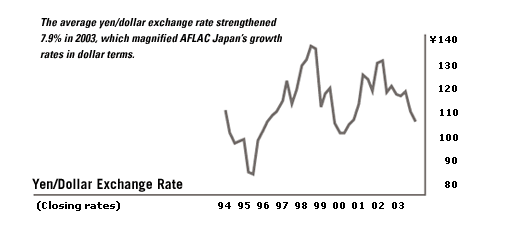
AFLAC Japan built on its many competitive strengths in 2003. We expanded our sales force and strengthened our brand. We also implemented new technology to better serve our customers and agencies. And we offered products that Japanese consumers wanted and needed, which led AFLAC Japan to another strong year.
Providing consumers with products they need is the key reason for our success. And our approach in developing those products gives us an edge in the Japanese market. We remain convinced that Japanís consumers desire affordable products that provide ďlivingĒ rather than death benefits. They also prefer premium rates that are level throughout a lifetime. And they want products from financially strong companies. That clearly describes our business in Japan. By continually honing our edge in Japan, we have produced an enviable record of success.
Below are some of AFLAC Japanís financial highlights in yen terms for 2003.
Total new annualized premium sales increased 11.9% to •121.2 billion, compared with •108.3 billion in 2002.
Premium income was •848.1 billion, up 6.4% from •797.0 billion in 2002.
Total revenues were up 6.1% to •1.0 trillion, compared with •956.7 billion the previous year.
Pretax operating earnings rose 12.6% from •117.4 billion in 2002 to •132.2 billion in 2003.
Because AFLAC Japan generates a significant percentage of our companyís revenues and earnings, the fluctuations in the value of the yen can affect our results as reported in dollars. Itís important to note that AFLAC Japan collects premiums in yen and pays benefits and expenses in yen. In addition, we hold yen-denominated assets to support yen-denominated liabilities. And except for a limited number of transactions, we do not convert yen into dollars. Therefore, currency changes do not affect AFLAC in economic terms. However, we are required to translate AFLAC Japanís income statement for financial reporting purposes from yen into dollars using an average exchange rate. And we translate the balance sheet using an end-of-period rate. Consequently, the translation of yen into dollars impacts the results we report in dollar terms.
AFLAC Japanís growth rates are magnified in dollar terms when the average yen/dollar exchange rate is stronger than in the preceding year. On the other hand, growth rates in dollar terms are suppressed when the yen is weaker to the dollar than in the preceding year.

In 2003 the yen averaged •115.95 to the dollar, or 7.9% stronger than the average of •125.15 in 2002. The stronger yen enhanced our reported results as reflected below in dollar terms.
Total new annualized premium sales increased 20.8% to $1.0 billion, up from $867 million in 2002.
Premium income rose 15.0% to $7.3 billion, up from $6.4 billion in 2002.
Total revenues were up 14.6% to $8.8 billion, compared with $7.6 billion in 2002.
Pretax operating earnings increased 21.6% to $1.1 billion, up from $938 million in 2002.
For more than 10 years, AFLAC has successfully faced the challenge of operating in a weak economy in Japan. Although there were some signs of economic improvement in 2003, the countryís economy continues to struggle. Economic weakness combined with the countryís aging population and continued increases in health care costs have forced changes in the life insurance industry and in the health care system. In 2003 the Japanese government increased copayments for participants in its national health care system, placing a greater burden on consumers.

|